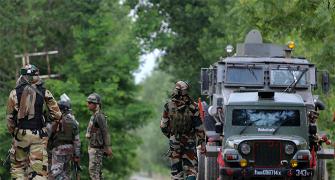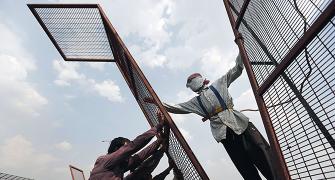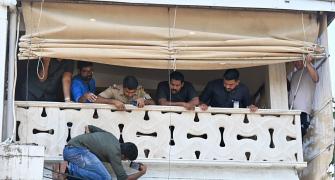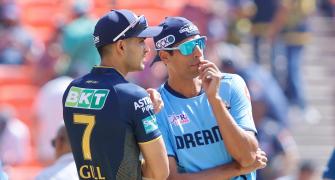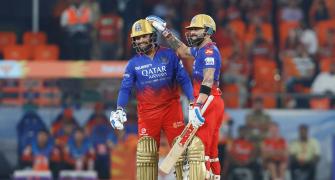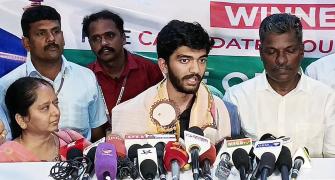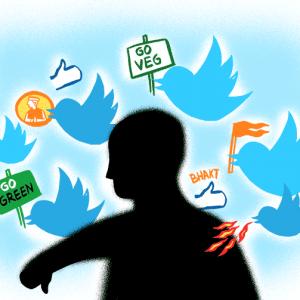'To identify with the common man, Modi had to look like one.'
'The disastrous suit with his name written on it never made its reappearance.'
'Frequent dress changes during the day, which led Arvind Kejriwal to calculate that Modi spent crores on his attire ever year, too stopped.'
'Instead, a newer Modi emerged: Humble and eager to serve.'
Narendra Modi has cleverly repositioned himself as a man of the masses in the past three years, says Aditi Phadnis.
Illustrations: Uttam Ghosh/Rediff.com
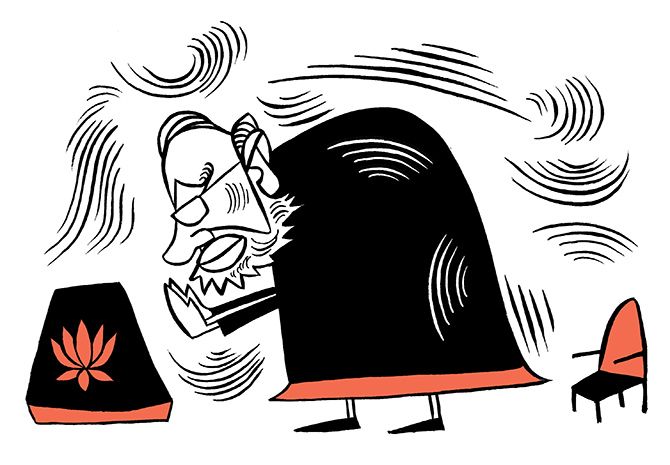
'I had not yet become the chief minister of Gujarat. One of the workers came and said Mr Bhatia has come "from GAD." I did not know what it was.'
'What I heard was GOD. So I thought he must be some sant or mahatma. When Mr Bhatia walked in, he did not look like a sant -- he was wearing pant-shirt. "Sa'ab I look after the general administration or GAD," he said.'
'He then asked if I wanted any change in the chief minister's chamber or anything to be installed. I told him: "Look, I’ll be frank with you. I have never been to the chief minister's chamber. But I have heard that the chair Keshubhai (Patel) used to sit on was like a king's throne. I don't want that.'
'Please get me a simple chair; don't buy one, you can get one from some other office.'
'The phrase, "Don't buy a new chair, get one in use somewhere," was all over the secretariat in less than one hour. That was my first message to the government and the bureaucracy.'
As the chief minister of Gujarat, Narendra Modi gave a series of interviews to the founder-editor of Manushi, Madhu Kishwar.
These interviews, conducted over a number of sittings in 2013-2014, provide fascinating insights into Modi's self-image, his encounter with power, his blind spots and strongest assets.
Most important, they are a chronicle of Modi's evolution -- the style and the man.
Some things about Modi have not changed after he became prime minister.
He continues to create and enjoy drama -- and his support staff does not disappoint.
Whether it is big events like Madison Square Garden (2014) or grabbing the drums in Tokyo (2014) or Dar Es Salaam (2016), Modi loves mischief and the unconventional.
If he invited all the SAARC leaders to his swearing-in ceremony, he took everyone's breath away by his visit to Raiwind, Lahore, to wish Pakistan Prime Minister Nawaz Sharif on his birthday and greet the family on his granddaughter's wedding with no particular foreign policy goal in mind, except to maybe just toss a political catalyst in the India-Pakistan mix and wait to see the reaction.
In this, he has proved without doubt that he is a great gambler.
But he is shrewd enough to realise that theatre and acting can be found out -- unless it is backed by action.
The 'We want to be friends, but we know how to be enemies as well' theme was delivered with panache and flourish with the cross-border surgical strikes.
Congress Vice-President Rahul Gandhi caught this and charged the prime minister with 'vanity and incompetence', adding that 'We never gave India a prime minister who based his entire policymaking strategy on TRPs.'
But since 2016, the Congress hasn't won a single election.
Modi, by contrast, led the campaign in Uttar Pradesh and told a few visitors who met him before the results were out that he thought the BJP would be able to form a government in the state.
His visitors got the impression he was expecting thye BJP to form the government, but just about.
In this, Modi was a victim of an error of judgment, arising out of the dire fears of mass unemployment following demonetisation.
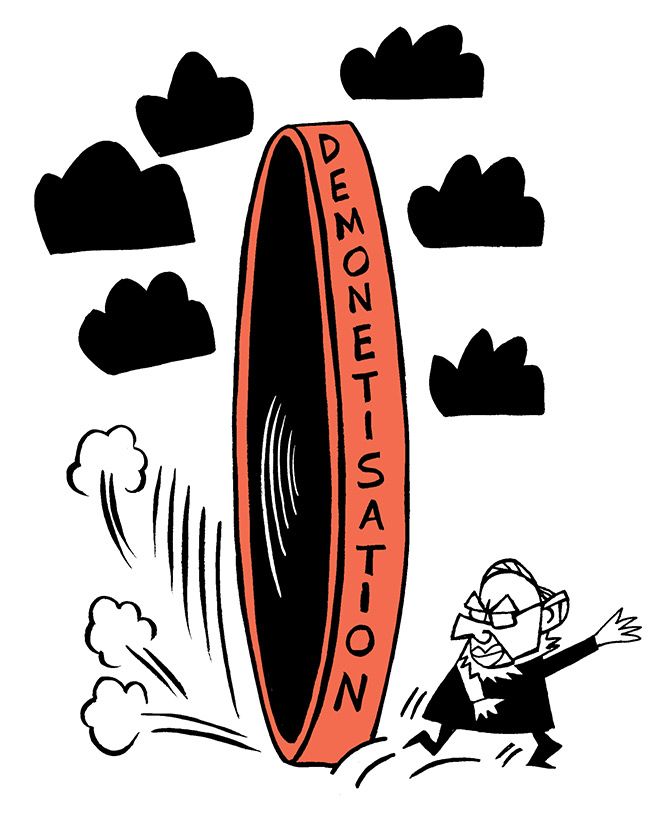
A visitor reported that this was possibly the only phase where he went through visible self-doubt.
That through his campaign he only spoke once or twice about demonetisation suggests that he felt it was politically wise to play it down.
Barring his January 2 speech at Lucknow and once more in eastern UP, the 'D' word was never spoken.
If the UP assembly election results were a pleasant shock, the appointment of a conspicuously Hindu chief minister in Yogi Adityanath was an even bigger shock.
A businessman asked Modi what had prompted him. "Given the available choices, he is the best," he said briefly.
"But he is a force unto himself… he won't listen to you," persisted the businessman.
"Yes, I know, he won't listen to me," retorted Modi, keeping his own counsel.
What was the thinking behind this?
Was it the dictum that if you want to destroy a man, give him a job he can't do? We will never know. But Adityanath was very much Modi's choice, not foisted on him by any other force.
A big element of Modi's style comes from two things: The way he deals with people, and the way he handles his ministerial colleagues and the bureaucracy.
If Manmohan Singh came across as reticent, Modi is the polar opposite.
Modi has the advantage of having a captive party organisation. But he never lets go of an opportunity to prove that he is not Pradhan Mantri but Pradhan Sevak.
In the initial days, it was different. Modi never let go off an opportunity to hobnob with world leaders and industry captains, especially if they came from abroad.
Business deals signed with other countries were flaunted with easy exaggeration. But Rahul Gandhi's jibe that this was a 'suit-boot ki sarkar' stung him hard.
He realised that business was still a bad word in India.
From then on, the discourse moved from attracting investments to the common man's issues.
More than business-friendly, he wanted his government to be seen as pro-poor.
That is when the schemes on financial inclusion, free cooking gas et al began to flow.
At an election rally in Lucknow, after his government had imposed price caps on stents, Modi asked his audience: 'Won't these companies be angry with me or not?'
The wheel had turned a full circle.
The messaging went down well. Desh Gujarat reported how on his way to the Africa summit in Ahmedabad, Modi ordered his convoy to stop, drew up in a small lay-by and waited -- all to enable an ambulance to pass.
The Assamese media quoted one Dhrubajyoti Kalita as saying Modi is 'our God' because he petitioned the PMO when his eight-day-old daughter who was suffering a rare lung ailment had to be airlifted from Guwahati to the Sir Ganga Ram Hospital in New Delhi to arrive at 7 pm, during peak hour traffic.
The PMO intervened and ensured traffic-free passage for the ambulance.
And to identify with the common man, Modi had to look like one.
The disastrous suit with his name written on it never made its reappearance.
Frequent dress changes during the day, which led Arvind Kejriwal to calculate that Modi spent crores on his attire ever year, too stopped.
Instead, a newer Modi emerged: Humble and eager to serve.
He has never been seen with the beautiful people of New Delhi.

No one remembers the darker stories from his days in Gujarat anymore -- snooping on the private life of a young woman by Gujarat's home ministry because 'Sa'ab' had ordered it.
The Mann ki Baat intervention is an important part of the Pradhan Sevak persona.
It is another matter that the largest number of listeners of Mann ki Baat are in Bihar (according to figures provided by the audience research wing of All India Radio) where the BJP lost the assembly elections resoundingly.
The programme itself has an impressive reach — 40 million listeners hear every episode, according to 2017 figures.
In one respect, Modi has not changed.
It is hard for colleagues to win praise from him.
Everyone was somewhat surprised when he gave Venkaiah Naidu the credit for the passage of the Goods and Services Tax Bill in Parliament.
In 2016, after both Houses had passed the Bill, he told Cabinet colleagues: 'I want to appreciate the efforts of Naidu. He has never touched the feet of anyone in his life... He has pursued the matter rigorously for the last two years, his interaction with various political parties and various leaders was remarkable....'
While in Odisha in 2016, after inaugurating an Indian Oil refinery, Modi said about Petroleum Minister Dharmendra Pradhan: 'A total of 2.6 million people got LPG connections in Odisha in 60 years, but after Dharmendra took over, 1.1 million new consumers were added in a year. This is how work is executed.'
Modi has tried to experiment with new faces as chief minister to create a second rung in the party, loyal solely to him.
Some have been efficient, others less so.
Modi's working approach, to be successful, needs enormous bureaucratic cooperation, especially as many ministers are struggling even after three years on the job.
Initially, the bureaucracy was enormously enthused by the fact that they could cut through the maze and seek direct access to the prime minister.
It promised to be a bureaucracy-led government when even before his swearing-in in May 2014: Cabinet Secretary Ajit Seth asked secretary-level officers to write a note on 'How things could have been different', and 'What if you are given a free hand in your ministry?'
Modi's innovation to videoconference with officials on a project on the last Thursday of every month (it could be infrastructure one month and sanitation the next) got enormous traction among officers.
But its effectiveness was limited.
At a 2016 meeting, Modi flagged his displeasure at the conduct of the custom and excise department.
All that happened was correspondence between CBI Director Anil Sinha and Revenue Secretary Hasmukh Adhia where Sinha asked Adhia to direct the Central Borard of Excise & Customs to prominently display phone numbers of anti-corruption officers if people wanted to complain!
And now the enthusiasm is waning.
"You can either appoint senior officers on the strength of merit or seniority. This government seems to be doing neither," says a senior IAS officer in the context of the series of supersessions in the bureaucracy.
When at least two women ministers got into disputes with their secretaries, it was the secretaries who were shifted out, not the ministers.
Changes in the home and finance ministries are seen by the bureaucracy as a means to extend PMO control over the ministries rather than ensuring efficient functioning.
The most telling is the bureaucratic reaction after the conviction of former coal secretary H C Gupta.
The bureaucrats feel this is the ultimate betrayal on the part of a government which had enchanted them three years ago.
For Modi, fighting on many fronts, bureaucratic non-cooperation is the last thing he needs.


